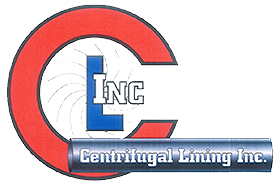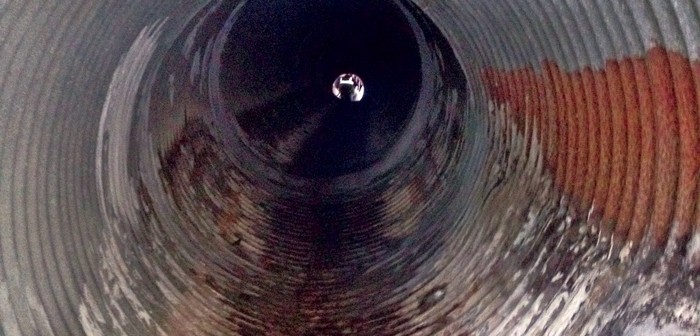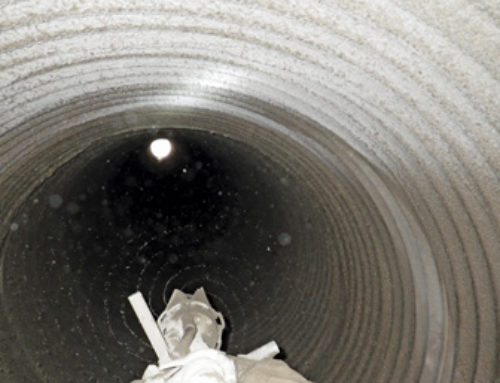After trial projects and letting several projects under emergency contracts, the New York State Department of Transportation (NYSDOT) now appears to view centrifugally cast concrete pipe (CCCP) as a mature and cost-effective solution for large diameter sewer repair.
A recent storm sewer rehabilitation project near Groton, N.Y., is a good example of this. The project was awarded to Arold Construction Co. Inc. via an emergency bid process, and vice president Ryan Arold sees that as something of a vindication. “We were the first in this area to see the potential of the CentriPipe spincasting process, and it’s nice to see the quality of the solution being recognized,” he says.
Before rehabilitation, the sewer was in bad shape, but not actually collapsing. “This was 195 ft of 42-in. diameter corrugated metal pipe (CMP) and it was about 40 years old,” says Arold superintendent Nathan Baldwin. “It had actually held up pretty well, given its age, but the invert was rotted out, there were large voids visible under the pipe, and in places the metal was folding up into the sewer. So, the pipe hadn’t collapsed, but was about to fail and rehabilitation was certainly needed.”
CentriPipe, from AP/M Permaform, is the oldest and most thoroughly researched CCCP solution. Basically, it relies on a precisely controlled spincaster that is inserted into pipe and withdrawn by winch, depositing thin layers of high-strength cementitious grout according to engineered specifications. The process creates a brand new, structurally sound concrete pipe that adheres tightly to the original substrate, so that flow capacity is minimally affected and annular flows are restricted.
Compared to cured-in-place pipe (CIPP) and other trenchless solutions, staging areas for CentriPipe are small, which proved to be an advantage on this project. “The downstream end of this sewer had an 8 ½-ft fall to a trout stream, so we couldn’t work from that end,” Baldwin explains.
That left a catch basin, roughly in the middle of the 195-ft stretch being rehabilitated, and about 12 ft by 15 ft in area. The catch basin floor was 3 ft below the sewer inlets and outlets, so an important part of preparation was the construction of a small raised winch platform in the basin, anchored with lag bolts.
Work began with sewer preparation. This began with cleaning and tar removal. Then, holes in the invert were patched and voids were filled with concrete, and a new invert was poured with PL-12,000, a self-consolidating mortar made by AP/M Permaform — a solid, flat invert is essential, because it allows smooth withdrawal of the spincaster and even layers of new pipe. The project’s general contractor took care of dewatering, accomplished with pumps (during a rainy week) and an upstream weir. Silt fencing was placed as needed to avoid contamination of the trout stream — this was minimal, as CentriPipe is a clean process with little overspray.
With the pipe and site prepped, concrete casting could begin. Arold used PL-8000, another high-strength mortar that sticks well to most substrates, even when damp, including CMP. For this project, 2 ½-in. plus layers were applied.
“Because we were between two runs in the catch basin, we did the upstream run first, about 80 ft, then spun the winch around and did the downstream run, about a 110 ft,” Baldwin says. “We were able to do both runs in a day fairly easily.”
PL-8,000 cures quickly and adheres well to itself, so application of successive layers can usually begin the following morning. But this particular project did come with a surprise.
“We discovered that the upstream treatment plant uses this sewer to release effluent most weeks, at a rate of 150 gpm,” Baldwin says. “And no one had let them know we’d be working in the area.”
This wasn’t a dangerous situation — upstream noise gave plenty of warning, and the spincaster hadn’t yet been inserted — but it was an unexpected ‘flash flood’ that overwhelmed pumps and took most of a morning to work around. Still, the second layers went on the same day and the project wasn’t appreciably delayed. Total time on site was about a week.
A Quality Solution
Quality control on CentriPipe projects is straightforward. In some cases, small gauges or pins are attached to sewer walls to measure the thickness of individual layers and final thickness. But in this case, the CMP was uniformly round and Arold could verify layer thickness with before and after interior measurements with a tape. Material tracking is also useful; PL-8,000 is stored in bags and mixed onsite and the number of bags used can be translated to total volume of material applied as a second check of layer thickness. And layer thickness and adhesion is also tracked during application by the spincaster operator, who uses radio or hand signals to control winch withdrawal speed. NYSDOT inspectors were also present for most of the project, performing visual inspections.
It’s important to note that this method of sewer rehabilitation creates a new pipe within the old sewer, a new pipe that doesn’t depend on the original substrate for support and is structurally sound in itself. So even in cases where the original sewer is failing structurally, CentriPipe can be used in thin layers with no additional material. And where special conditions exist, admixtures can be used; for example, where old concrete sewers have failed due to microbiologically induced corrosion (MIC), the new concrete can be mixed with ConShield from AP/M Permaform, an antimicrobial agent that permanently inhibits the microorganisms that create hydrogen sulfide.
Perhaps best of all, CCCP is a cost-effective solution for large diameter pipe. Several projects have shown conclusively that CCCP costs less per foot than CIPP or sliplining. For example, after completing three major CentriPipe projects, Hilton Head Island Storm Water Administrator Cary Gaffney wrote in a 2013 article; “At larger pipe diameters — about 30 in. and up— (CentriPipe) is highly cost-effective compared with CIPP and requires far less staging area.”
Highlighting another advantage of CentriPipe, compared to other trenchless sewer rehabilitation methods, Gaffney also wrote, “Minimizing interference with island traffic is an important consideration when a priority is keeping roads and golf courses open,” and says that CentriPipe’s short timelines and modest staging area requirements meant that traffic is rarely disrupted, even on relatively big projects passing under major roads. And winter projects in New York and Saskatchewan have shown that the process can be successfully used in very low temperatures — as low as -45 F in Saskatchewan.
CCCP, in general, and CentriPipe in particular have proven to be practical, structurally sound, and long-lasting repair methods that are cost-effective and easy on traffic, with only minor impact on flow capacity. In nearly all situations where large diameter sewer needs to be permanently repaired or replaced, this innovative trenchless rehabilitation method should be considered.
Angus W. Stocking, L.S., is a licensed land surveyor who has been writing about infrastructure since 2002.



